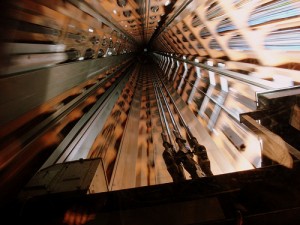The following is a guest post by Erin Engle, Digital Archivist, NDIIPP.
When my family and friends ask what I do at the Library of Congress, I invariably get questioning looks when I use the phrase “digital preservation.” The looks turn even more quizzical when I talk about my work managing a project focusing on the preservation of geospatial information. It’s a double whammy of confusion that often leads to “oh that sounds very interesting” when the person means “I have no idea what you’re talking about.”
Digital preservation is such an abstract topic that it’s hard to describe with a proverbial 30 second elevator speech. I talk about how we as a society – institutions and individuals alike – are creating more and more digital content (photos, videos, electronic documents) with the latest software and hardware technologies (computers, smart phones, apps).
I mention that we may want to save some of this content, maybe not all of it, for posterity because what we create today represents our cultural digital heritage. I go into the technological and social challenges associated with providing access to the content in 50 or 100 years. “That’s where digital preservation comes into the picture,” I declare earnestly. “It’s the series of actions to archive, or preserve, digital materials to ensure they are accessible in the future.”
For those looking for a more structured description, many institutions and organizations define digital preservation in similar or slightly different terms. At NDIIPP, we say digital preservation is the active management of digital content to ensure long-term access over a period of time (we even produced a nice 3 minute video about it). The American Library Association’s short definition states that “Digital preservation combines policies, strategies and actions that ensure access to digital content over time.” The Digital Preservation Coalition’s handbook notes that “Digital preservation refers to the series of managed activities necessary to ensure continued access to digital materials for as long as necessary.”
But describing what digital preservation is doesn’t describe my job. Because what’s left out of talking about the “it” is the social side of preserving digital materials. And this is where roles and responsibilities for the “active management of digital content” come into the picture.
NDIIPP has always said that no one institution alone can preserve our nation’s cultural digital heritage; it requires a network of collaborative, committed partners to create a national digital collection. It’s the same for the professionals working in the field. Various people with expertise in different domains within organizations and partnering institutions are needed to decide what digital content should be archived, to work with subject matter experts on archiving digital content, to build the technical infrastructures to support the transfer, workflow and storage for large amounts of data, to design and create interfaces or software for users to access the data, and to foster collaborative relationships for the stewardship of digital content.
A large institution must rely on more than one person to perform these responsibilities. (There certainly is no one “digital preservation” librarian or archivist here at the Library). The action and tasks of preserving digital content requires collaborative teams, who are able to function within their respective individual roles while understanding the roles and responsibilities of each other.
In my position, I deal with the social side of digital preservation. I work with the brilliant people who perform the tasks of archiving content, the data managers who ensure multiple backup copies are made and secured, and the NDIIPP partners who are working directly within their content communities on archiving and preservation challenges. Much of what I do on a daily basis deals with promoting the relationships among these various experts and teams within the Library and within our NDIIPP partnership network. I also perform outreach activities to raise awareness of the benefits of personal digital archiving, help develop programs about digital preservation for various audiences, and think about innovative ways to enhance our social media and web communication strategies. My work aims to make it a little easier for everyone to understand the importance of preserving digital content.
Call me a dreamer, but one day I hope it will be as easy to describe digital preservation as it is to take a walk in the park!


